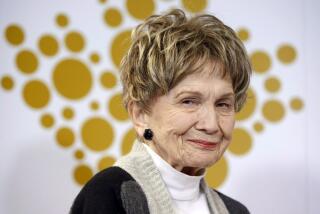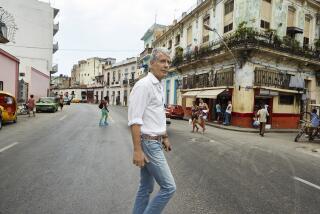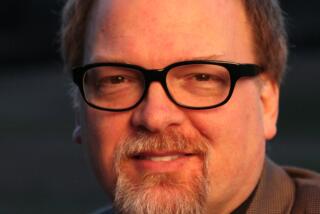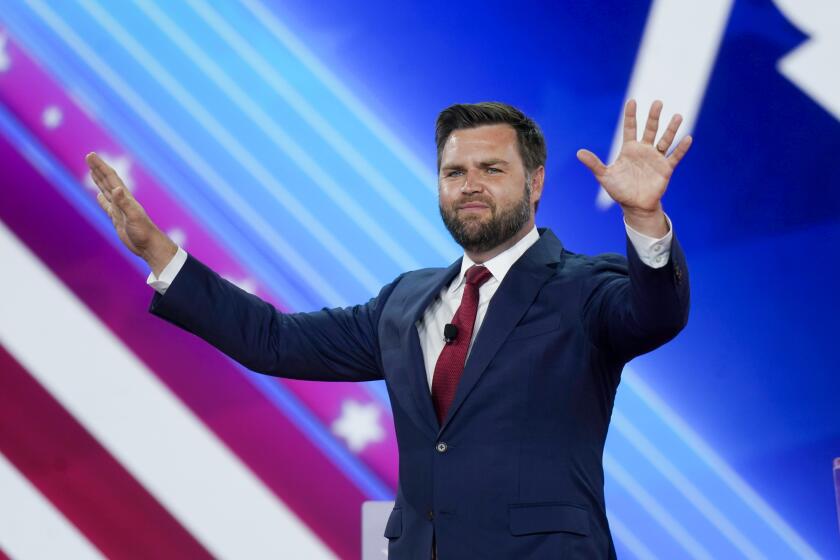Nostalgic Flashback to the 1960s : Photographer’s Candid Stills Chronicle Life as a Hippie
Lisa Law became “the only hippie” in her family when she walked straight into the ‘60s 22 years ago. Her personal odyssey took her from the Burbank home where she grew up to San Francisco and Hollywood and the rock music scene with Dylan and Janis and the Beatles. To Haight-Ashbury and Woodstock. Flower children and Vietnam protesters and civil rights marchers. Communes and love-ins.
Along the way, she took pictures with a Leica given her by friend Frank Werber, then manager of The Kingston Trio. The result is her photographic portrait of those years, “Flashing On the Sixties,” just published by Chronicle Books.
“I was 22 and daring and went wherever the moment took me,” Law, now a 44-year-old professional photographer in Santa Fe, wrote in her 160-photograph chronicle of the period. “The music scene was starting to happen. . . . The war in Vietnam was escalating, Martin Luther King Jr. was leading the fight for civil rights, people were dropping acid as often as the pill and music was expressing it all.”
During an interview in Los Angeles last week, Law recalled: “I was so excited about what I was seeing that I wanted to remember it. I wanted to put on film what I saw. . . . The music and the demonstrations, civil rights and anti-Vietnam, the back to the land movement and the festivals. I saved and cared for the negatives. There are thousands. A lot of people shot pictures then. They either lost the negatives or are doing something else. I stayed with the era.”
Law has remained in touch with many of the people she met during those tumultuous years--a few close friends, including Baba Ram Dass and actor Hugh Romney (aka Wavy Gravy), have written text for her book.
Commenting on her generation now, Law said: “They’ve changed their clothes and cut their hair, but they still have the same values. I think they still embrace the philosophies of the ‘60s.”
It took Law 10 years to find a publisher after deciding that she should do a book on the wave-makers of the era.
“I realized my job, my role in my lifetime was to share the decade with the public,” she said. “Perhaps because I was not a professional photographer and therefore was not taken seriously by anyone, including myself, I was able to record some of the more relaxed moments from those heady days.”
In 1959 Law had left Burbank, where she was raised with two brothers by her father, Lee Bachelis, a furrier and union organizer, and mother, Selma, a lawyer, and had gone to San Francisco to live with an aunt. There she met Werber and eventually went to work as his personal manager.
But the ‘60s really began for Law in 1965 when she met Tom Law, road manager for Peter, Paul and Mary, and moved into a Los Feliz mansion with him. Law, his brother actor John Phillip Law, and a friend, Jack Simons, had bought the four-story house called the Castle and rented out suites.
Although the cast of residents at the Castle kept changing, among those Lisa Law photographed are Bob Dylan, Andy Warhol, Severn Darden (an actor from Second City and the Committee), Barry McGuire of the New Christy Minstrels, Tiny Tim and Wavy Gravy.
“Wavy said it was the Bohemia of the West,” reminisced Law. “I shot Tim Hardin’s first album cover at the Castle, in the backyard with all the purple ice plant. I remember when Lenny Bruce came, he said to me: ‘You and I have one thing in common, we have the same nose.’ ”
In the book, there are several intimate photographs of Dylan, of whom Law recalled: “Though he didn’t stop me from photographing him, I was never comfortable doing it. He had a stare that intimidated me and took my breath away.”
There also are shots of the Kingston Trio and We Five in Mill Valley, the Lovin’ Spoonful and the Beatles in San Francisco, Janis Joplin and Big Brother and the Holding Company in Marin County, Ravi Shankar at the Monterey International Pop Festival, Warren Oates and Peter Fonda filming “The Hired Hand,” Dennis Hopper editing a film in New Mexico, actor Harrison Ford fixing the wiring at Severn Darden’s house, Allen Ginsberg and Timothy Leary at the Human Be-In in Golden Gate Park in 1967.
After a brief stay in Mexico in 1966, Lisa and Tom Law moved back to the Bay Area, where Lisa recorded the flower children of Haight-Ashbury, Hari Krishna followers and yoga classes, the peace marches and, in 1969, Woodstock. The Laws and other members of their New Mexico Hog Farm--a back-to-the-land commune--ran the kitchen and helped build the stage and other facilities for that watershed concert.
By that time, the Laws had married (“We were looked up to in those days as being the perfect couple”), had been living in communes in New Mexico and had one child. After Woodstock, they returned to New Mexico, where they lived on John Phillip Law’s farm.
The couple subsequently had three more children, and continued living in Santa Fe until 11 years ago when they divorced.
A cabinet salesman, Tom Law now lives in New York with their youngest child, son Jesse Lee Rainbow, 13.
Their son Solar Sat Baba, 18, and daughter, Sunday Peaches, 15, live with their mother near Santa Fe. The oldest daughter, Dhana Pilar, is 20 and a sophomore at UC Davis.
‘80s Reminiscent of ‘60s
The late 1980s, Law admitted, remind her of the ‘60s. “The beginning of this decade didn’t. But now . . . people want to become involved with their values, the real issues. And the songs (of the ‘60s) are coming back. Music has always been the great catalyst. Through music, we have Live Aid, Band Aid, Farm Aid, Cowboys for Indians. People raising money to help people.”
Law is planning another book about the ‘70s, the decade when she feels the cultural changes of the ‘60s were implemented. “People were digesting in the ‘60s,” she said. “In the ‘70s, there was women’s lib and now women have a better place in society, then all these self-help groups were started, people working with birthing and dying. Gay rights--people came out of the closet and made a statement.
“We are of an age now where we are making a statement in society, rather than dropping out of society,” Law said. “My book is a healing book in a way, I think.”
More to Read
Sign up for our Book Club newsletter
Get the latest news, events and more from the Los Angeles Times Book Club, and help us get L.A. reading and talking.
You may occasionally receive promotional content from the Los Angeles Times.






